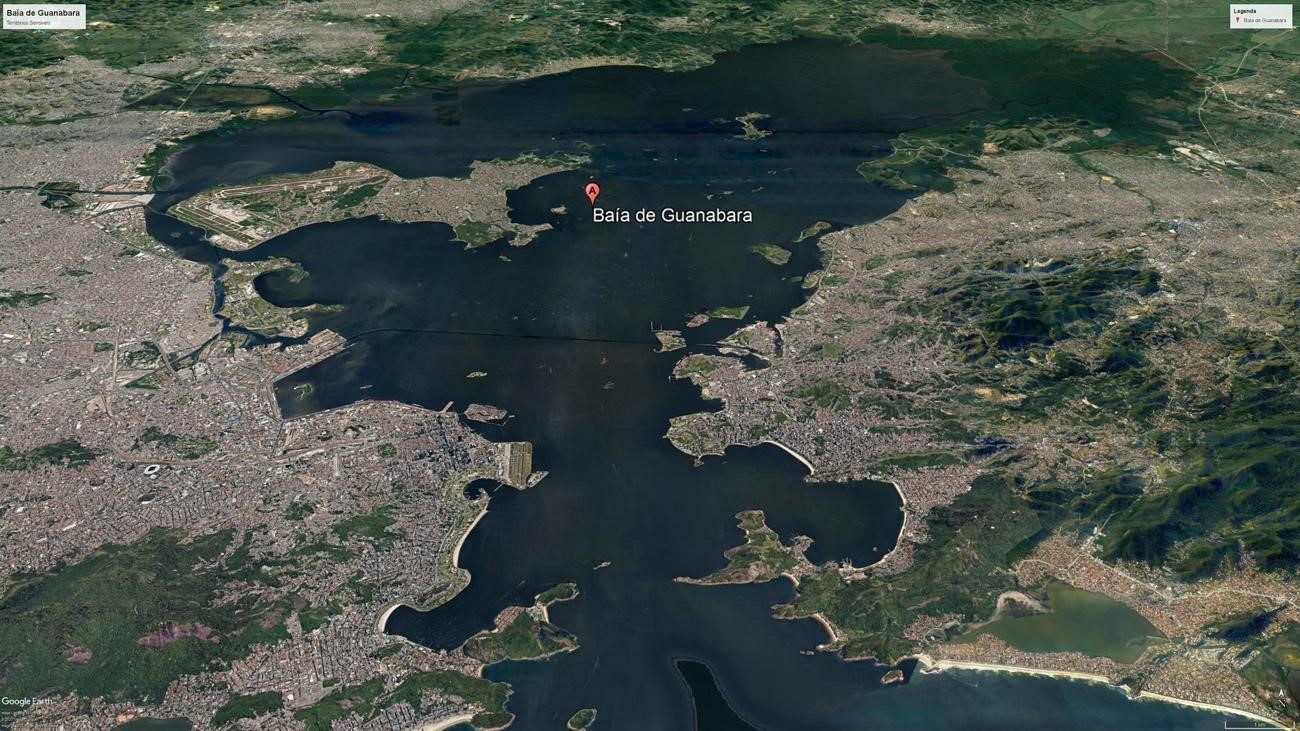

In face of the current global crisis, especially within the Brazilian context of colonisation and excessive exploitation of its natural resources, the project Sensitive Territories[1] has been establishing, since 2014, collaborations amongst artist-researchers, scientists, environmentalists, and local communities across Brazil. By focusing on the impacts of climate change and contemporary ways of living, these collaborations have been proposing different modes of co-existence and co-creation between humans and nonhuman entities, by strengthening ethical-political and participatory ways of making art.
Throughout 2019, the project took place in the highly polluted Guanabara Bay in Rio de Janeiro, specifically at two places: “Colônia Z-10” (one of the first fishing villages of Brazil) which belongs to Ilha do Governador, and the Island of Paquetá. For over 100 years, “Colônia Z-10” (located on the river banks and mangroves of the Jequiá river) and its several fishermen families has stood on land donated by the Brazilian Navy. Nowadays, it is completely suffocated by the water pollution of the Jequiá river and the Guanabara Bay and as a result, only 400 out of 5000 inhabitants can still make a living out of fishing. This heavy pollution is part of the everyday lives of the community, creating serious health issues that remain almost imperceptible to these bodies asphyxiated by the neoliberal system.
Paquetá also has a fishing history, but the island is better known for its nickname “Island of the Lovers.” Since, in the past, the island was known for its paradisiac beaches, not only the King of Portugal used to spend his holidays there, but also the famous soap opera “A Moreninha” was shot there in the 70s. Nevertheless, these days Paquetá has similar problems to those of the Colônia Z-10, which in summary can be described as moving between a distant past and a close future, between local traditions and environmental crisis, and/or between survival and the formation of new narratives.
Within this troubled scenario, four artistic laboratories were set up, gathering a group of twelve artists and ten collaborators. These laboratories consisted of performative actions, somatic practices, workshops, performances and discussions. Anchored in the methodology of Performance as Research — PAR (Arlander; Hunter and Rose Riley), these laboratories aimed to produce a form of embodied and situated knowledge by always focusing on the making process and the engagement with the local communities. Furthermore, they served as a framework to explore concepts such as territory (Haesbaert), embodiment (Spatz; Massumi) and emplacement (Pink). For us, these concepts operated in two different ways: on the one hand, as a driving force for the proposed actions on the islands and on the other, as a source for deepening the relationship between the body and territory.
In terms of Rogério Haesbaert’s (2013) account of considering a territory in Latin America as a complex understanding of processuality, the specific conditions of the two islands and the more general scenario of the Guanabara Bay offered us: a) a common ground on which new relations and life pathways were created, b) a dynamic process through which some particular aspects of the socio-political and environmental issues of the islands came to light and c) a higher awareness towards our bodies and the ways in which they are always situated and traversed by the multidimensional, material and immaterial trajectories of a territory. In addition to that, we see our artistic and embodied practices not only belonging to the field of socially engaged art, but also to the Brazilian performance art’s tradition of the 1960s and 1970s (e.g. Hélio Oiticica, Lygia Clark and Lygia Pape) which has been influencing the ways in which such a situated (or Latin American) body is enlivened and/or manifested.
This collaborative writing will provide an insight into four of the twelve actions that were realized during the aforementioned laboratories, while sharing some of the manifold entanglements, knots, and trajectories, which emerged out of the waters of the Guanabara Bay.
Surrounded by the Jequiá river and mangrove, the Z-10 colony holds layers of historic memories to what it means to live in the Guanabara Bay; a sacrifice zone[2] due to the progress of a devastating oil industry. Surprisingly, the inhabitants of this community are not so aware of how important such a mangrove ecosystem is for the maintenance of their daily lives. By acknowledging its existence and memory, the artists and locals engaged in a type of place making in which the mangrove and its flying roots were put center stage. This way, their bodies entered into a process of constant displacement, while pointing out and crossing issues that form an embodied knowledge, which, according to Brian Massumi (2002), emphasises the experiential dimension of a body in movement.
Attuned to this idea, Walmeri Ribeiro and Ruy Cézar Campos carried out the following actions. In the case of Walmeri (fig. 1), she worked with the children of the Colony through the simple actions of breathing, meditating, feeling, listening and dreaming. How can we breathe with the mangrove? What does it bring to us? From a sensory experience surprises, dreams, and learnings emerged which were then transformed into drawings and phrases. This action fostered the discovery of the mangrove as being part of their bodies/homes as well as the discovery of its movements, sounds and flying roots.

After that, Walmeri invited the residents as well as the collaborators and the artists of the project, to participate in a performative action together with the mangrove and the wall/frontiers of the houses constructed irregularly in the banks of the river, causing the mangrove to suffocate. In a simple gesture of standing still and of breathing with the eyes fixed on a certain point of the mangrove, the following directions were given: Remain still. Turn to the right. Keep the rhythm of your breathing. Look at a point on the wall. Remain still. Turn to the left. Turn your eyes back towards the mangrove.
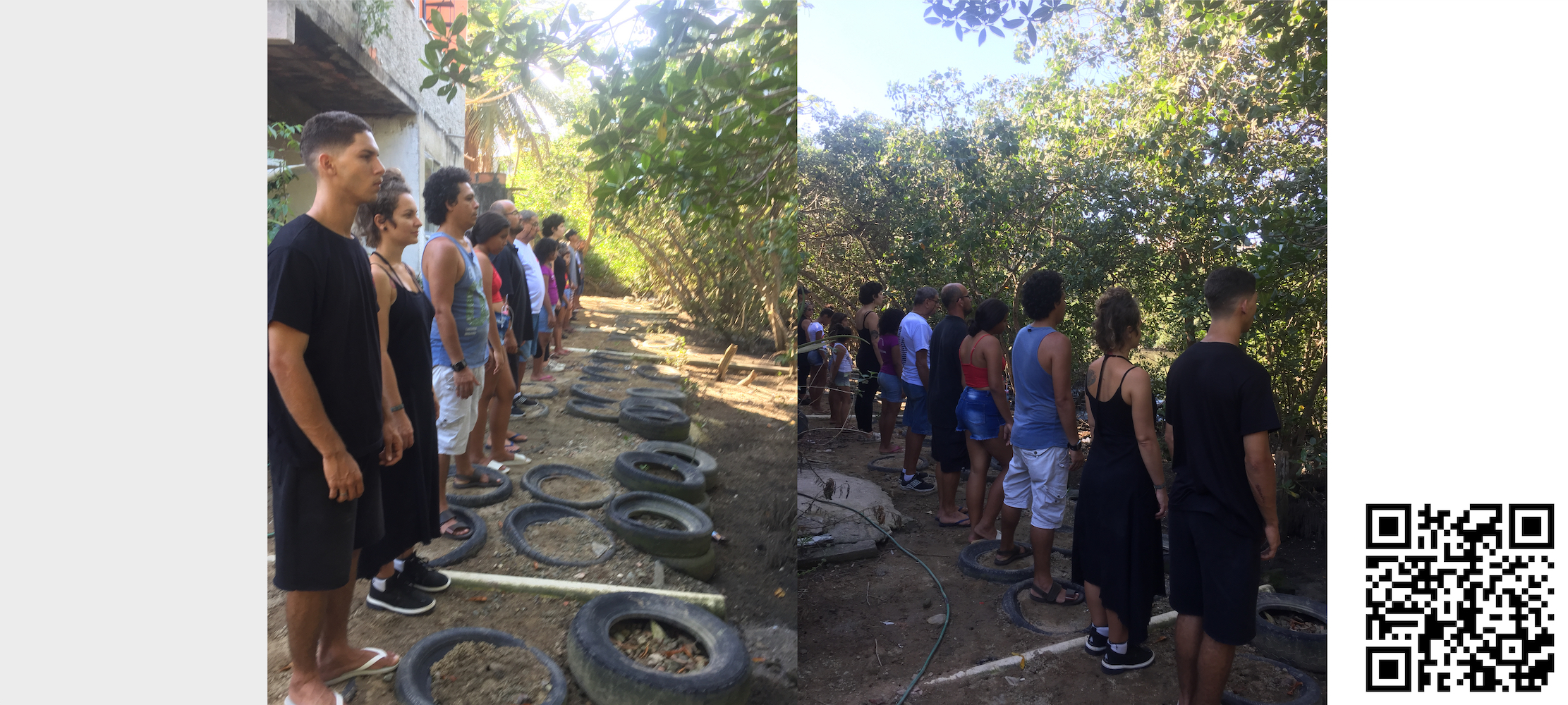
Breathing together and becoming-mangrove was a performative gesture, a sensory and political action. Through synchronizing the rhythm of our lungs with the movement of these flying roots, we learned that we can rethink our small gestures and habits by disrupting our ways of living and inhabiting the world as well as by bringing change — even if micro-geographically. We also acknowledged that there are ways of sharing the mangrove’s strength, flexibility, porosity, and capacity for the creation and reinvention of life — even when it comes to adapting to unexpected materials such as a duct piece.
We found this five-to-six-metre-long black duct lying on the mangrove’s muddy ground during the first visit to the Colonia Z-10 and it became the basis for Ruy’s intervention. One of our collaborators, Tiago Caiçara, explained that it had floated across the Guanabara Bay, moving through the tide reflux directly to the mouth of the Jequiá river, where it damaged a few small boats. Caiçara got the others to help him drag it out of the river and placed it on the ground close to the mangrove’s roots. He used a small part of the duct to make flowerbeds on the village’s main square. The duct piece that was left became part of a video-installation assembling the sounds of the mangrove, with a collage of different images and moments of perceptual engagement with the village memory.
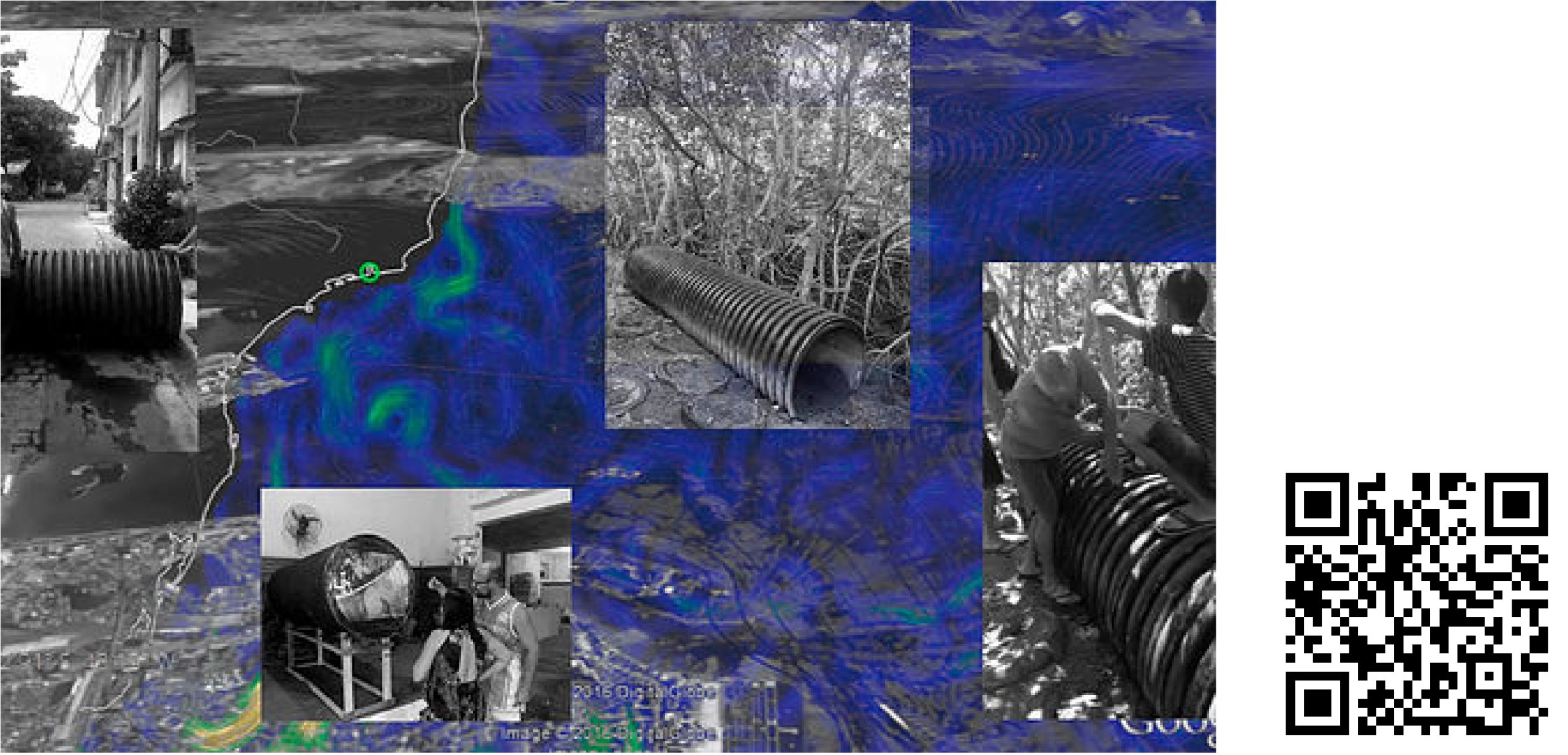
For the creation of the video-installation, Luiz Antônio (L.A.), one of the few younger fishermen who is respected by the elderly, took part in a performative walk and sound recording moment through the mangrove to formulate questions to be posed when we interviewed the most traditional fishermen, Mr. Geraldo (G) and Mr. Zuca (Z). By doing that, we evoked, provoked and knotted together dispersed intergenerational stories and memories of this place, as they remembered the time it was flooded by the oil spill of an Iraqi vessel, in 1975.
(L.A): Do you remember seeing any odd trash of your past?
(G.): – Of course!
(Z.): – Yes!
(G.) – There was one time this burned down. – There was a fire. A huge fire here in . . . 1974, right?
(Z.): – Yeah.
(G.): – In 1974. A big fire, yeah. Some ships… … from Petrobras…
(Z.): – It spilled oil!
(G.): – Yeah, it spilled some oil. That oil was black and invaded this place. The waters suffered, here on the mangrove. This mangrove, from here to there, all the way to there, wasn’t here. It was sand. The mangrove was from this point to that over there. That destroyed everything. Why? There was some disagreement or so. The fire started here.
(Z.) – It was a fuss!
(G.) – It was ruined here. People were trying to get out.
They also shared with us that in the year 2000, a duct disruption caused a dramatic oil spill in the Bay. A month later (and after our laboratory had finished), due to another oil spill, the fishermen went on television to demand the attention of the authorities towards the health of the Guanabara waters.

This type of petro-political narration (triggered by unusual encounter with the duct piece) as well as the walking, breathing and sensing together with the children and youngsters of the Z-10 Colony, and with the nonhuman entities that compose this territory (the mangrove, the river, the ocean tides, the waste, the smell, the pollution, the boats, the birds etc.), were the base of our artistic mediations on this territory. Like this, our gestures moved from embodiment to emplacement: a form of place making that was affected by a shared performative and sensory experiences made within the Colony. For both the artist-researchers and the community, these embodied experiences enhanced the understanding of this territory, of its ecological past and present memories. Most of the residents who worked with us had never visited the mangrove in their backyards and these experiences were the first to acknowledge it in an ecological approach, giving special attention to the interconnectedness between individual, communal and non-human agents. This can also be seen as an artistic-political and pedagogical act as the ways in which life moves on despite the fact of living in the sacrifice zones of the Anthropocene.
During the laboratory in Paquetá, Cesar Baio[3] and Nathalie Fari created subtle interventions that aimed to make visible some of the hidden narratives of the island. By using different yet complementary approaches, they looked at how the relationship between embodiment and technology (in this case, the technological device of a camera) affects not only one’s own perceptual experience, but also the ways in which images evolve.
While Nathalie got a sense of the indigenous ancestrality of the island, especially due to a somatic and performative work she facilitated for the participants of the project (based on the moving meditation practice of the 5Rhythms as well as on improvisation), she also created a photographic series in collaboration with a local member of the community, in which she enacted the position of lying down (or of being dead) at different spots of the island in order to (re)imagine a process of devastation and decay.
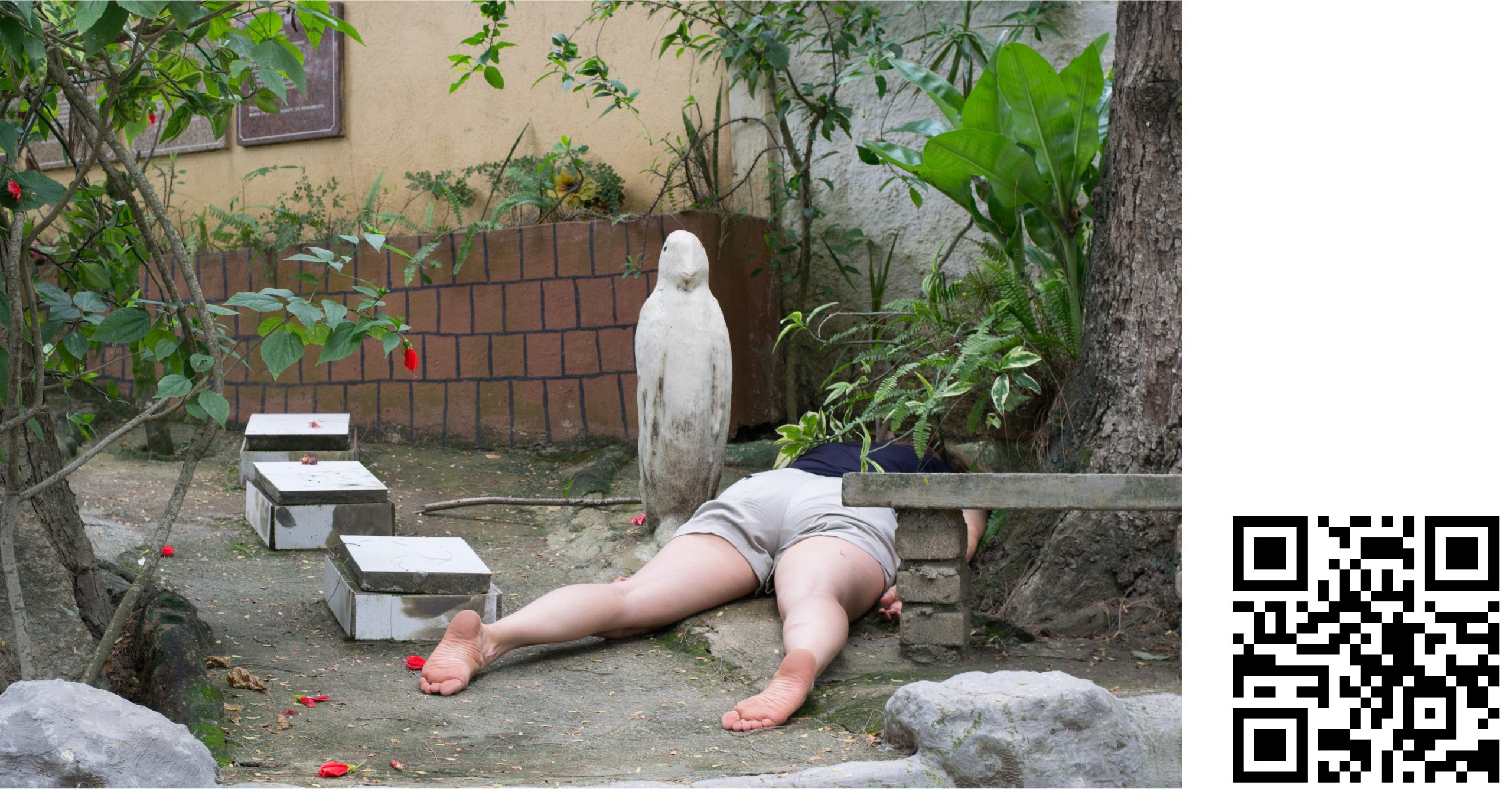
This experience or her somatic, site-oriented and documentary approach to performance practice, is attuned with Ben Spatz’s (2017) concept of the “embodiment as first affordance.” Anchored in Gibson’s (1979) notion of affordances,[4] Spatz takes a step further, pondering on what else embodiment can be and do for us, beyond the already accepted approaches of the dissolution of the division between body and mind, or the phenomenological “lived body.” Instead of just emphasizing how the body acquires and sediments a specific technique by, for example, engaging with a specific place, Spatz makes an attempt to place embodiment at the junction between ecology and technology. He states:
Our bodies, in other words, are an intermediate zone – a hinge, pivot, or junction — between the ecological and technological. […] It is only in recognition of the urgent disbalance between ecology and technology that we have cause to prioritize embodiment as the fragile junction between these domains. In light of this disbalance, embodiment is not just any affordance, but first affordance, the affordance from which it might be possible to reorganize the relationship between technology and ecology. (267)
When trying to hold on to such an intermediate zone, we must be aware of the tensions (or discrepancies) that might arise at the junction described by Spatz, that is, between the goal of pursuing an artistic and/or embodied practice and the urgencies of an environmental crisis which can barely be put into images or words. In the case of Nathalie’s action, this might imply that although she made an effort to embody and portray the specific ecology of Paquetá, it cannot be assured that her intention restored some of the environmental disbalances of the island (this can probably be applied to all the other actions). Nonetheless, the images of her body lying amidst the corners and edges of Paquetá, brought to light not only the remains of the paradisiac status of the island, but also its more recent problems with waste, pollution and toxicity. In her work, the body’s actions reconnect technology an ecology, and, in doing so, the artist finds her own ways of moving from the idea of embodiment to emplacement.
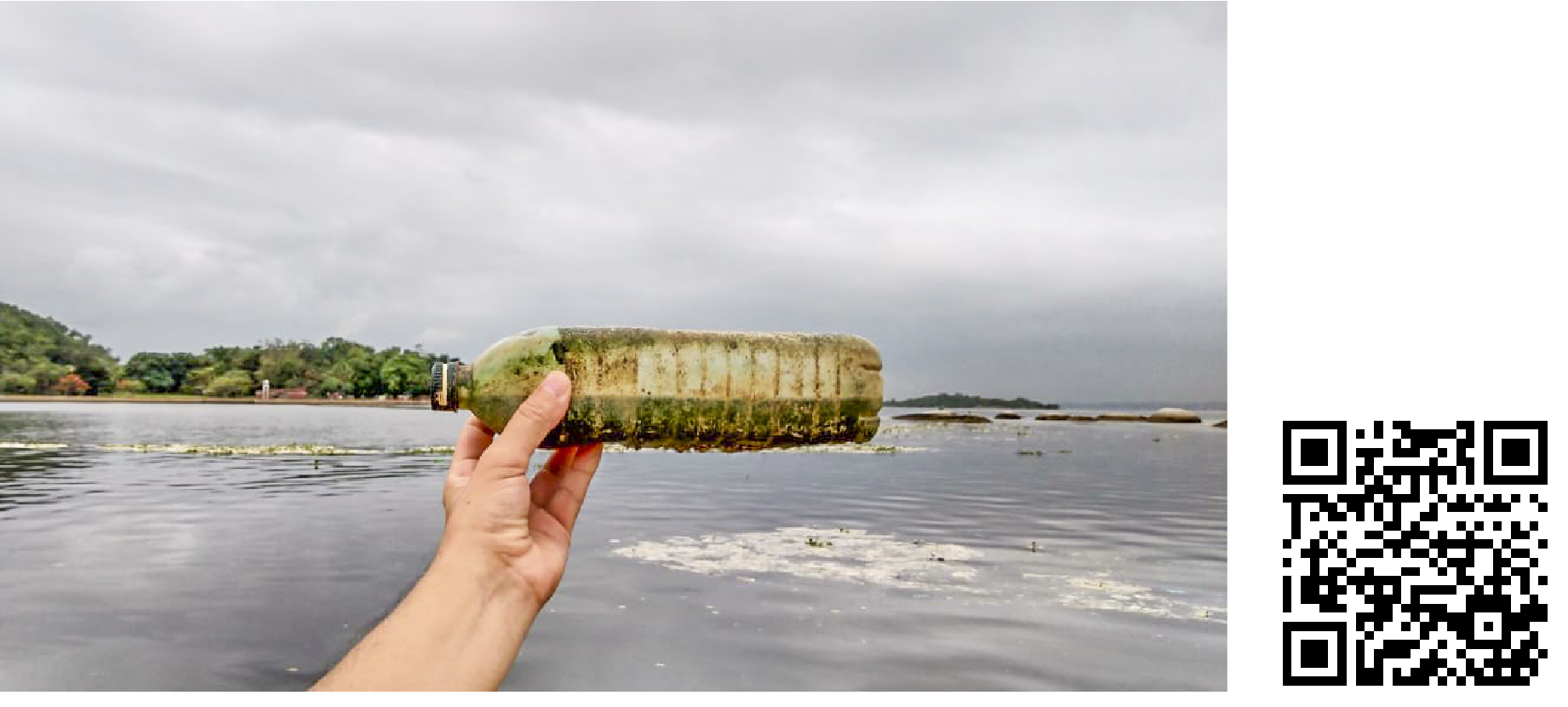
Whereas Nathali’s work created images that altered the sense of place, in this way underlining the importance of images for the imaginary of a place, in Cesar’s work the node between technology and ecosystems lies in waste objects that are industrial products. Entitled “Obliterações” (Obliterations), César’s work had as point of departure to investigate the ways in which the inhabitants relate both to the garbage stranded on the beach and to the beach itself. In doing so, a group of inhabitants of the island joined the artist on a series of walks along the beaches in order to open their senses towards the sand, especially, towards the sight of ships, oil platforms and the floating garbage moored on the beach. The next step was to enable the group to search for lost objects that they could use to cover parts of the visible landscapes. What parts of the island should be seen and which unseen?
In his work, non-human entities are reused once more to become part of a different technological and ecological construct, and this is how his artistic proposal finds a way to alter the sense of place (through emplacement) in an empowering mode. In Cesar’s case, it happened through a body that relates to an object as part of a world yet to be known and built. Like this, the artistic action provided meaning to what was once an industrial product and now became a homogeneous and impersonal object which is free of any subjectivity prior to the state of being a discarded object.
A core issue of embodied mind theory is the refusal of the separation between perception and action. As such, once perception and action evolved together by depending on each other, the enactment turned into a key concept to understand the way we relate to the world (Varela et al.). From this embodied perspective, to know the world means to act upon it. In Obliterações, the found garbage became a way of producing knowledge and of acting upon the world, or of what Elena Pasquinelli considered a “workable object” (235) in reference to Merleau-Ponty’s concept of “practicable” object.
With this found object, an imaginary landscape can be created that is neither a scene of everyday life, nor the idyllic mirage seen by the traveler. At the moment in which this landscape emerges, it embodies the subject who has invented it, while reallocating the state of the knowledge about both the place and the subject. The body of the found object, the one that makes up the observed landscape and the one that is the subject of the experience, generates a new place. Although ephemeral, what is engendered at this moment has already changed the status of the place, and the scenes of what emerges is documented in the photographs shown in the artwork. Although using photography as media, this artwork does not intend to create a representation of the world, of a subject or of a community, it aims to build a place to be inhabited by the artists, local collaborators and the community’s members. A place as vast and perennial as the artistic act itself.
A key intention of our collaborative writing, was to exemplify how the aforementioned actions offered us different ways of embodying a territory/place or as Sara Pink would ask: “How can we learn to occupy or imagine places and ways of perceiving and being that are similar, parallel or indeed interrelated with and contingent on those engaged in by research participants?” (34).
Although we cannot give an answer on behalf of all the participants of the Sensitive Territories project, we can affirm that our shared laboratories fostered a common ground for enhancing as well as re-situating our embodied experiences, be it in connection with the more general environmental and/or petro-political issues of the Guanabara Bay or more specifically, with the past, present and possible future configurations of the two islands. In that way, both our artistic processes and the encounters we had with the local communities were central for generating, on the one hand, a series of artworks and research outcomes and on the other, a type of apprenticeship which consisted not only of learning how to listen and sense an environment, but also of how to access and integrate its multiple layers of memory and history. As such, this process of embodying a territory or of becoming “emplaced” enabled the co-creation of new narratives or even better, new imaginary spaces, while being co-constituted through something we denote as affect.
By looking closer at the “affective encounters” we had in the Guanabara Bay, we might argue that while for Cesar it meant grasping the familiar yet toxic landscapes of Paquetá through the non-human agency of objects, for Nathalie it offered the possibility of accessing through her own body the rather mythical and forgotten past of the island. When it comes to Walmeri and Ruy, we will say that while for Walmeri such an encounter had the connotation of being deeply entangled with both the mangrove and the inhabitants of the Colônia Z-10. For Ruy it represented an ethnography-based approach of uncovering the traces of an embodied technique and/or craftsmanship. In doing so, all these encounters enhanced not only the aforementioned “body-mind-environment” continuum or the oscillation between embodiment and emplacement, but also the empowerment of multiple agencies, whether human or non-human.
In this regard, we will conclude by stating that such embodied territories touched upon the ways in which an embodied technique or embodied knowledge might affect (or be affected) by a territory/place that is neither fully captured nor conquered, i.e., a territory that trains our bodies to be “all eyes, all ears and all hands.” In other words, while our eyes, hands and ears helped us to create the performative actions at Colônia Z-10 and Ilha de Paquetá, they also might have been responsible for changing some of the ways in which the local communities perceive or even influence the development of their troubled and threatened environments.
The Sensitive Territories project is supported by FAPERJ— ResearchFoundation of the State of Rio de Janeiro| “Young scientist our State” fellowship— E-26/202.778/2019. And, between 2019-2020 the project had a grant from Prince Claus Fund and Goethe Institut.Proof reading by Nathalie S. Fari, PhD candidate at academy of music and drama, University of Gothenburg. ↑
Naomi Klein understands the places in an extractivist economy as “to their extractors, somehow don’t count and therefore can be poisoned, drained, or otherwise destroyed, for the supposed greater good of economic progress”(Klein169). ↑
Grant 2018/24452-1, São Paulo Research Foundation (FAPESP) ↑
In Spatz’s article, this notion is explained as: “those possibilities that a given physical environment ‘offers’, ‘provides’, or ‘furnishes’ to an ‘animal’ that lives within it” (259). ↑
Arlander, Annette. “Introduction to future concerns: Multiples future of Performance as Research? ”Performance as Research: Knowledge, Methods, Impacts. Edited by Annette Arlander et al. Routledge, 2017. https://doi.org/10.4324/9781315157672
Alencar, Emanuel. Baía de Guanabara: Descaso e Resistência. Mórula Editorial, 2016.
Haesbaert, Rogério. “Global sense of place and multi-territoriality. Notes for dialogue from a ‘peripheral’ point of view.” Spatial Politics: Essays for Doreen Massey, Edited by David Featherstone and Joe Painter. Chichester, 2013, pp. 146-157.
Klein, Naomi. This Changes Everything: Capitalism vs the Climate. Allen Lane, 2014.
Massumi, Brian. Parables for the Virtual: Movement, Affect, Sensation. Duke University Press, 2002.
Mapping Landscapes for Performance as Research: Scholarly Acts and Creative Cartographies. Edited by Lynette Hunter and Shannon Rose Riley, Palgrave Macmillan, 2009.
Pasquinelli, Elena. “Varela and Embodiment.” Journal of Aesthetic Education, vol. 40, no. 1, 2006, pp. 33–35. https://doi.org/10.1353/jae.2006.0001
Pink, Sarah. Doing Sensory Ethnography. Sage Publications, 2015.
Spatz, Ben. “Embodiment as First Affordance: Tinkering, Tuning, Tracking.” Performance Philosophy, vol. 2, no. 2, 2017, pp. 257-271, https://doi.org/10.21476/PP.2017.2261
Varela, F. J., E. Thompson, and E. Rosch. The Embodied Mind: Cognitive Science and Human Experience. The MIT Press, 1991.